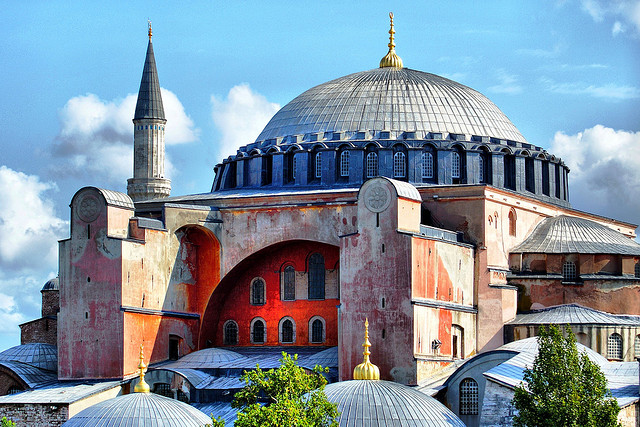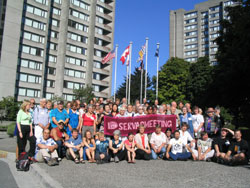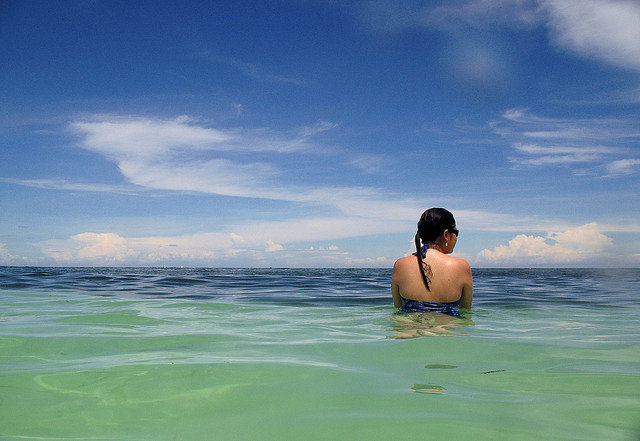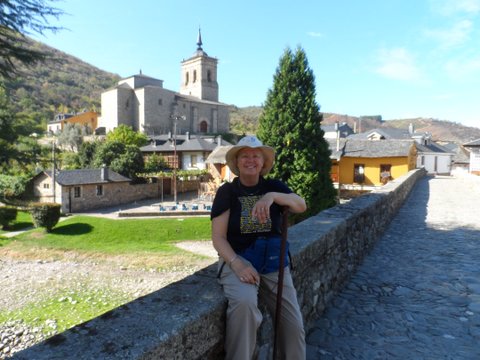My friend Carol, a wonderful and unique woman in her early 50s, is a high school math teacher, a gifted painter, a very decent piano player, and what else – a world traveller. I only really met her about a year ago or so, but once I found out all the places that she’d been to I knew I had to do an interview with her.
Carol has been travelling since the 1970s, and she has forged some amazing connections with 2 countries: Turkey and Greece. She lived in Turkey for close to 8 years and has made life-long friends in what she calls her “second country”. And she’s also developed some close ties with people in a special little village in Greece. Here’s her story:
1. Please tell us a bit about your travel experience in general. What places have you visited?
It started with my first trip to London, England, to visit my uncle when I was 16. That trip changed my life and opened the world up to me. I basically led a sheltered life in Scarborough (a suburb of Toronto) and really had known nothing else. The trip to London gave me this travel bug that has never left. I backpacked Europe the summers of 1972 and 1973, that’s when you could do “Europe on 5 $ a day”. Greece was the cheapest – we managed on 2$ a day!
The next summer I went out east to P.E. I. and the next summer out west to Victoria.
After university in 1976 I took a few years off to travel. My sister joined me for the first year. We started in Paris, visited our dad in Communist Czecholosovakia, hit the beaches of Yugoslavia – Makarska, and then on to Greece. After Greece we flew to Israel to work in a Kibbutz. I had to see what was going on in that country that was so much in the news. I stayed 8 months and then went to be an au-pair girl in Paris for 11 months. Back to Greece followed by a great trip to Turkey, Jordan and Syria in July 1978 and then back to real life in Toronto.
I always made shorter trips back to Greece once I became a highschool teacher. And to the States to visit friends I had met on my travels. A wedding on top of the World Trade Center, a friend in Memphis besides the memory of Elvis, and a friend in San Francisco where I fell in love with the Golden Gate Bridge and another in Manhattan.
I quit my full-time highschool teaching job after 4 years and went on a trip to Tokyo, Hong Kong and Thailand. The timing was close – we were in Tiannanmen Square one month before the massacre of May 1989.
From 1989 to 1999 I worked as high school teacher in Istanbul, Turkey, coming home twice for one year and once for half a year. My love affair with Turkey began. Before I came back to Canada for good in 1999, I had the pleasure of visiting Australia, a great country with the friendliest people.
2. You have a very special connection to a village in Greece called Parga. Please tell us about your first encounter with the village of Parga.
The first time I went to Parga was in 1976. I had been working at the O’Keefe Center [a famous concert venue and theatre in Toronto] and an usher there had told me about this wonderful village in Greece he used to go to in the summers. He produced a postcard with a beautiful beach and uttered the word “Parga” as if it were magic. He couldn’t speak much English so I didn’t even know where it was located in Greece.
In September 1976 on my big trip with my sister, having just come from Yugoslavia, we were staying on Corfu. Corfu seemed too touristy to us, so we wanted to visit another place in Greece. My idea was Crete. It seemed far but on the way to Israel. We couldn’t decide so I just opened a map of Greece and my eye went directly to “Parga” (a tiny village in the northwest of Greece, so small it is sometimes not even on the map). Parga!!!!! Then I remembered that magical word uttered by the usher. “Let’s go”, I said, and fortunately it was close to Corfu. The travel agent was surprised we were asking directions on how to get there. It wasn’t too popular with foreign tourists yet. And she added, “the young men are beautiful”. Well, that did it! We left that day.
A ferry trip 2 hours to Igomenitsa, and a 2 hour bus ride south. We arrived in the evening and we found a room for the night and walked along the waterfront of the village. It was beautiful – 2 small islands in the port with a church, a castle on one side on the hill, and mountains behind.
We ate “brizola” (pork chops) and than sat at the café “Parga Bar”, discussing our plans which included not talking to any young men for a week because we were tired of the men in Yugoslavia who came on too strong. At that moment one of the most beautiful men I had ever seen walked up to us with his friend who spoke English and asked if he could sit down. My sister said “No”, I said “Yes”. I was mesmerized. They both had rooms to rent, one above a disco, and one just in the building beside us. One for a $1 a night and one for $2 a night. We picked the second one not above the disco. Lefteri looked like a Greek god or like a young Marlon Brando. He had a friend, Camille, a Canadian woman who was in Parga for the 3rd time. He brought her to the table and we became instant friends.
To make a long story short, we stayed for a month in Parga, having the time of our lives. It was a small unspoiled fishing village then, only 3 people spoke English and there were very few tourists in September. And the young men were beautiful!
Lefteri, Camille, and many of the young men who are now in their late 40s and 50s, my sister and I are still friends who reminisce of the good old days of the summers of 1976 to 1979.
3. Since your first time in Parga, your relationship with this village and its people has evolved. Please tell us a little about the human connections.
I have always gone back to Parga for my holidays, unfortunately it is too far and too expensive to go every year. In 1976 my sister Elaine made friends with a teenager by the name of Christos, who was at the disco every night, dancing up a storm and was one of the three people who spoke English. He invited us to have coffee with his mother, a remarkable mother, who extended her hospitality to us (“ksenis”). Foreign women were not looked on favourably in the village at the time, and probably even today, as it seemed we were there to take the young men. I remember the first female tourists who married and stayed to live in the village. That was 1976. Now there are at least 40 of these marriages. (Maybe the local women’s paranoia was justified).
Gia, Christos’ mother, became my Greek mother. Either she “adopted” me or it was the other way around. How many hours I spent in her tiny house with 2 rooms, the tiniest kitchen, and the most magnificent view I have ever seen. She fed me, kept me company, taught me Greek and slowly we communicated. She had a wonderful husband Vagelis, who I had coffee with every morning down in the village. And 7 children, mostly grown-up by then – 6 boys and 1 girl.
Christos and Lefteri came back to Toronto with us in 1978. Christos had never slept in a bed until then. Lefteri went on to visit his brother and sister in Chicago, Christos stayed with us for 4 months and saw snow for the first time. He now lives with his wonderful partner, Jo (from England) in Brussels with 3 beautiful children and he still loves “patates” (French fries).
Lefteri still lives in the village with his wonderful young Greek wife Marilena and 3 beautiful children. He used to run 2 discos and the “bouzoukia” in the olive grove. He has had a restaurant now for many years. Who knows where he learned to cook….
Many of the young men I used to know from the 1970s still live and work in Parga. Most have families of their own. Some are still single, many have their own businesses.
4. What is your favourite memory of your stays in Parga?
I have many favourite memories of my stays in Parga. I’ll mention 3. One is always there and will always be there every time I go. I can always count on it. It is the moon, especially when it is full. The full moon rises at one side of the village, it makes its way across over the beach and finally sets on the other side above the monastery. There is nothing to match it. Everyone there knows I love the full moon – “panselino” it is called in Greek.
My other favourite memory was a bar called “Stavlos”, run by Giorgo and Angelo from Veria. Giorgo started it on a shoestring in 1978 – the best bar ever! A bottle of Retsina (Greek wine) – 17 drachmas (50 cents)! And ‘toast’, like a grilled cheese, for a dollar. And usually you could make it yourself as Giorgo was too absorbed with his girlfriend at the time. My sister and I were his first customers, many hours were spent there watching the people walk by. He seemed to be always open, even after the discos, at 4 am. A great atmosphere! How many glasses we washed (we helped him out)….
Giorgo became my Greek brother and unfortunately he had to close down after a few years due to rising rents. I followed him wherever he worked – the islands of Paros, Santorini and Kos, and his hometown of Veria near Thessalonika. He married a Danish woman who has also become a very good friend of mine. They now live in Denmark and have 2 beautiful children. I have been to visit them 3 times. I love Denmark!
My 3rd memory is my connection with the Avloniti family, Christos, his mother, his father and siblings. They made me feel a part of their family. Vageli passed away 12 years ago and sadly Gia passed away last year. Parga will never be the same without her and neither will I. Finally though, after 5 years, I am going to see Christos, Jo and the family this summer in Parga at the end of August.
5. You also spent a significant amount of time in Turkey. Please tell us where and how did that come about?
The first time I visited Turkey was July of 1978. My travel companions were two gay friends, one from Jordan and one from Britain. We took various buses to Jordan from Athens and stopped in Turkey and Syria on the way. What a trip! It was the year “Midnight Express” came out, a movie that didn’t show Turkey in a favourable light at all, and Turkey did not seem the most desirable country to go to.
I knew nothing of Turkey, and imagined a country of “swarthy mustached barbarians”, the typical stereotype. How wrong I was!
Back in Canada I eventually became a highschool math teacher. After 4 years I had enough and quit. I wanted to work in Greece for a year, but there was a problem with work permits. A friend phoned me in March of 1989 and told me he saw an ad in the Globe and Mail for English and Math teachers in Istanbul. I applied because I figured it was close to Greece. I was hired and off I went to Istanbul with 13 other Canadians to work in a private high school. Little did I know that it was in the far suburbs of Istanbul.
We were given apartments by the sea, with a view of the Princes’ Islands. But we were isolated, no TV, no telephone, no English newspapers in our suburb. Work was difficult: 38 students in each of our 6 classes. And nothing to do at night.
I almost came home in March of 1990. But I started to be enamored with Istanbul during that summer and decided to come back and work in the center of the city. After one year back in Canada I did just that and stayed until December of 1998.
6. What was it like living and working in Turkey?
Living in Turkey was hard at first because of the language barrier. It became easier once we found our way around and learned some Turkish. I discovered many of the teenagers did speak English. And then it became very easy, because the Turks were so helpful. I never worried about finding my way. If I asked there was always a Turk to show me or take me where I wanted to go. Even when I didn’t ask and looked lost. Turks really like foreigners. My neighbour sometimes looked at me as if I were from outer space. But my last neighbours were the best I ever had, so generous and kind.
Because I couldn’t afford expensive apartments I lived many times without central heat. I wasn’t used to being so cold in the winter. Now though many apartments have gas heating. Also in 1993, there was a water shortage for 400 days! More than a year! Our water was shut off most of the time, except every second evening and morning, and was never on during the weekend. We had to save water in containers. I had a lot of watermelon, hot dogs and pizza.
Electricity cuts were also quite common. One day we went for 3 days straight without any electricity. All the food in the freezers got spoiled.
A lot of things didn’t work right, but a lot things did. It was easy to get anything fixed, for example. There were repair shops everywhere since the poor couldn’t afford to buy new things.
Istanbul had a few malls, and lots of stores, but I bought many things from the vendors on the streets, trains and ferries. There was action everywhere. There were few beggars, the very poor held shoe-shining jobs, sold tissues, balloons, chicklets, lemonade, cold water, cucumber pieces, watermelon – anything to make a buck. I especially liked the pickle vendors.
You could also shop from your home, on the street a different vendor would walk by and utter a special call announcing his arrival, for example the plumber, the guys who collected old metal, the yoghurt man, the tomato and vegetable man, the used furniture man, the potato and onion man who came in a horse and cart, a man who sold a special millet drink in the winter. His call sounded like the word “boze”, which he sang in a special melody, which I loved.
Another thing I loved were the movers. If you needed a pick-up truck, you just went to the intersection where they congregated and bargained a price, no booking ahead required.
Teaching in Turkey was a bit different than teaching in Canada, for the first years we only taught 3 ½ days of the week. This was fantastic. Then the Turks got “smart” and realized no other country did this.
I found teenagers to be the same everywhere. The students were no different really than here. The 11 year olds – my favourite group – were “younger” in maturity than here, which was nice to see. They seemed to grow up more slowly there. No drugs in high school. Many schools had a system where the students did an extra year after Grade 6 to learn English intensively for a year.
Now they learn from kindergarten.
The system of testing was a bit different and more bureaucratic. Each class had 6 big common tests per course, which were taken during the regular school time. One thing I thought was very strange, was that the foreign teachers had to go to the general meetings which were held in Turkish.
I taught in 3 different high schools, my second was a charity-funded boarding school for children without fathers – wonderful kids. My last school was in the center of Istanbul and I had the privilege of working with an excellent team of English teachers, both foreign and Turkish, of which many have become friends. I was there 4 years, it was hard to leave then, but I visit now every year.



